
The weather is not always perfect for motorcycle riding. If you commute by bike, you will have to keep riding through rain, through storm, in the mist, and maybe even while it snows.
On your holiday, in the Alps for instance, you can suddenly be caught by bad weather.
Are there any tricks to keep upright in heavy storm? And what are the d0's and don'ts when the road is slippery?
On this page, we have gathered tips for motorcycle riding in extreme weather conditions.
![]() Er is een Nederlandse versie:
Er is een Nederlandse versie:
http://www.luiemotorfiets.nl/tips/weer/
Heavy rain on motorcycle

Wet!
Obviously, the biggest problem of riding in heavy rain is that it's a hard job to keep yourself dry.
When you have a Windstopper collar around your neck, and it is half under the collar of your
coat, it will get wet, and will transport water to what you wear beneath your jacket.
Water can enter your gloves from your sleeves, or, when your pants are to short, it
can enter your boots.
And even worse, you can get wet all over in case you forgot to bring along your rain gear.
Really waterproof
There is not much you can do about it, apart from trying not to forget to bring your rainsuit along, and to perfectionate your gear, for instance by checking the length of your pants when you buy a new one, or by checking the cuffs of the sleeves on how they will prohibit rain from entering your gloves.
During the winter, you will often wear a suit that is warm as well as waterproof. During the summer you will often wear something which is not waterproof: a leather suit for instance.
In such a case, you should bring along a special rain suit, or, like you see here, a waterproof jacket and pants that were made for bycicle riders.
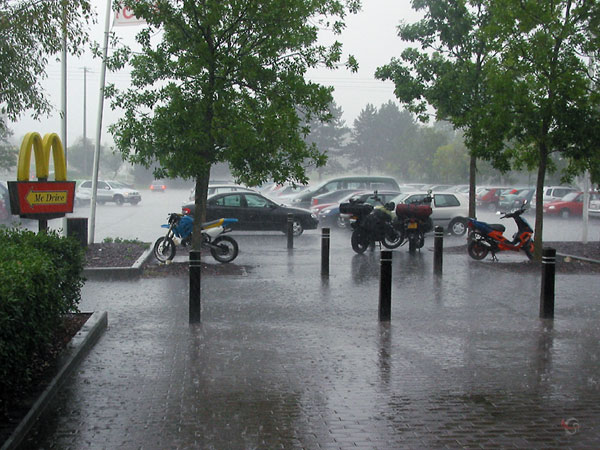
Slippery?
Wet tarmac is not by definition slippery. In principle, most of you could ride how you ride on dry tarmac, because on the street, you will probably not ask everything you could ask of your motorcycle and your tires. As an illustration, take a look at the MotoGP in the wet: they lean far more than most of you will ever reach under dry circumstances (but of course, their tires are better and the tarmac of the circuit is better).
But unfortunately, there are also places and times when the tarmac is slippery when it rains:
The first rain since a long time
If it has been dry for a long time, remember that the roads will be slippery during the first
rain!
Dirt and oil will have been spoiled on the road, and it takes some time before the rain
will have washed that away.
You can detect that by the foam that you will notice on the road: when you see foam, be carefull!
Especially the stretch before a traffic light is infamous: there will almost always be (some) oil, and when it has not been washed away, you'd better be carefull when you brake.
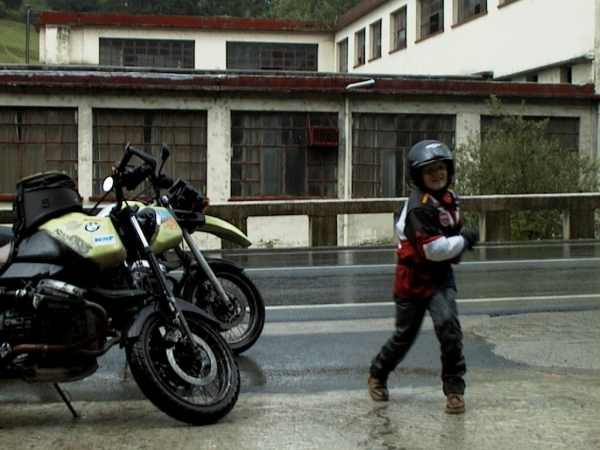
What you can(not) see
Another problem of a wet road in the rain is that you can't see how the road surface looks like. The stretch before a traffic light for instance: when it's dry, you can spot slippery looking places, but in the rain, you can't discern them anymore.
Reparation stripes
Reparations of the tarmac are made from "bitumen". You can see them in the form of black stripes, and you can't see them anymore when it rains heavily.
The problem is that those bitumen stripes can be very slippery. Some combinations of tires and motorcycle will really slide when you cross such a stripe.
Try not to get scared (well, that's easier said than done), and especially, try not to react, but instead try to hold the throttle in the same position: your motorbike will then be able to find its balance on its own.
Other slippery spots
Other (in-)famous spots are the white stripes and arrows on the road. Especially those made of plastic: you should try to prevent crossing them in a corner.
Painted white stripes are less slippery, but they are more slippery than plain wet tarmac.
Work on the road
When traffic is guided to another part of the road because of work on the road, be prepared that white stripes may have been painted black temporarily (so you can't notice them).
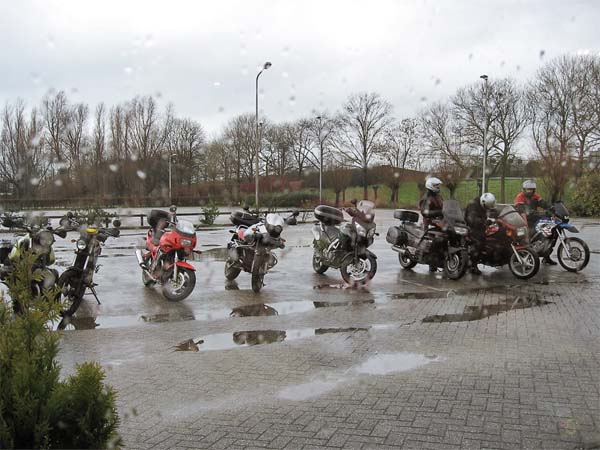
Aquaplaning?
Whoever has experienced it once in a car, aquaplaning, will want to know whether that can happen on motorcycle as well. Aquaplaning happens when there is so much water on the road that the tires cannot guide it to the sides, which means that the tire no longer has contact with the surface of the road, and the bike rides, as it were, on water.
Fortunately, the risk of aquaplaning on a wet road is much less than for a car: the tires of motorcycles are round instead of flat, which means their capacity for moving water to the sides is much bigger.
But if you ever see the rpm's rise quickly, you know that you should adjust your speed.
And if you ever would consider broader tires for your bike because you like the look of them, remember that the risk of aquaplaning is higher with broader tires.
Visor
When your visor is not clean, it will have a bad influence on what you can see when it rains: raindrops will stay separate drops instead of flue together to form a single film. All those raindrops work as many distortioning lenses, and on top of that, they spread out lights of cars or streetlamps, so they will hinder your view tremendously.
So keep your visor clean, and keep the surface polished. You can use Turtlewax after cleaning (but be sure to test it beforehand on a corner of your visor).
When you ride in the rain with a visor with a smooth surface by Turtlewax, the raindrops will form a single fim of water, which you can get rid of by turning your head to the side, from time to time,
Motorcycle riding in heavy storm
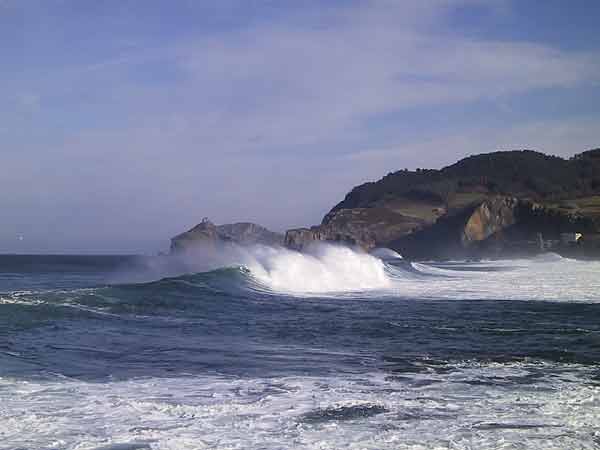
Stay at home?
When is it ok to take your bike and ride during storm, and when is it time to stay at home?
Generally speaking, it is simple: when you wouldn't go out walking, or in a car, you'd better stay at home.
If there is a danger of falling trees, or heavy breaking branches, you don't want to be on the road, whether in a car, on a bike, or walking.
Stay loose!
When you ride through a storm, you will feel as though you have to use all your strength, and you will contract your muscles, to keep your bike on the road, to compensate for the gusts of the wind.
But counter-intuitively, that is not what you need to do. On the contrary, you should relax your muscles as much as you can!
Why relax?
When you relax as much as possible, and your head and arms and legs move about in the wind, your body will not conduct the gusts of the wind to your motorcycle, there will be no steering input from the wind.
When you contract all your muscles, every gust of wind will be translated into a jerk to the steer. And with every movement of the steer, your bike will set into a corner, while all you want is to ride straight on.
But how do you manage to ride in a straight line?
It might sound strange, but your motorcycle is able to ride in a straight line all by itself. You help your bike in the best way by applying the tric described below.
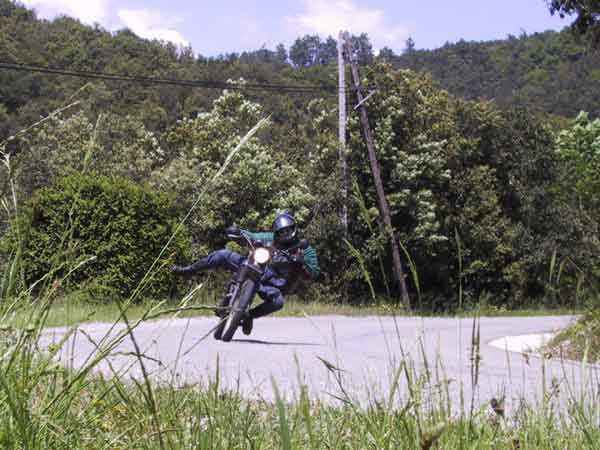
A flappering knee
When you do this for the first time during a storm, you will be surprised
about the effect:
If you stick out the knee at the side where the wind comes from, and you
relax your muscles in your leg, and let your knee flapper about, your motorcycle
will ride a perfect straight line.
The effect is simply baffling, especially when you were used to pull every muscle during heavy storms, to keep your motorcycle on the road, because you were certain that the wind would blow it aside.
But how is that possible?
You can imagine that your flappering leg will function as a sail, when the wind blows from an angle with your bike.
If the wind comes from the left, that means that the left side of the bike will try to decelerate. In the mean time, the wind blows the bike to the right, and both forces together compensate: as a result, the bike will lean in to the left, exactly as much as is needed to ride in a straight line.
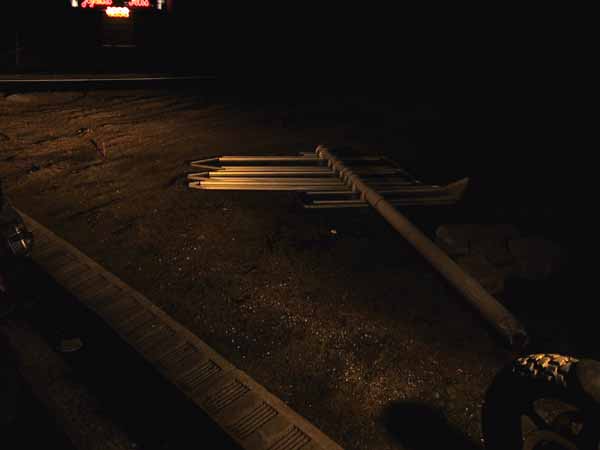
Blown to the side
So, to ride in a straight line through stormy weather is not very difficult. But when it's stormy and wet at the same time, and you cross metal strips on a bridge, or white plastic stripes on the road, you will be blown aside for a moment.
But the nasty effect of being blown aside after passing a truc will almost disappear when you use the flapping knee tric.
Stop
If the storm is heavy, and your motorcycle is heavy and high, you might get in trouble when you are forced to stand still at a traffic light.
In that case, you might consider returning home as soon as possible...
Motorcycle riding in the mist

No mist lights
Mist is a nuisance, when you are on motorcycle. If the mist is really thick,
there is the problem of not having mist lights.
That means that you should watch your mirrors even more often than usually, to
be prepared for cars from behind, who do'nt believe in keeping your speed down to
how far you can see ahead.
Visor
Another drawback that does not apply to car drivers, is that mist will form hundreds of small drops on your visor.
Gloves with chamois on the left forefinger, to wipe your visor clean, are really handy in those circumstances. And of course, what we told about rain applies as well: keep your visor clean.
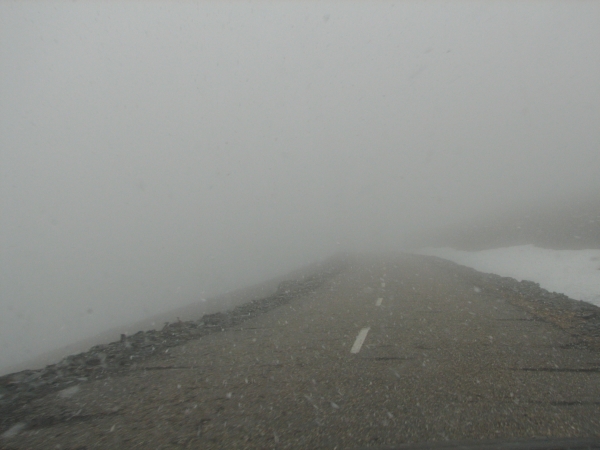
Yellow glasses
Of course, during mist, you take your sunglasses off.
But not everybody knows that yellow glasses will allow you to see
more during mist than no glasses.
Especially when you commute on motorbike, and regularly ride during mist, you really should have yellow glasses. The same applies when you go on vacation to the Alps or Pyrenees.
Most shops with motorcycle accessories have yellow glasses, and most gas stations as well. You could also try a do-it-yourself shop: safety glasses are sometimes available with yellow glasses (well, plastics of course). Cheap and very good.
Freezing mist
A special case is the situation that there is mist while the temperature is below zero.
Your visor will get a frozen layer, which you cannot wipe off. Your vision will become really bad: this is a situation in which leaving your motorcycle at home is the best option.
A complication is that the road may also get a layer of frozen mist, and because the ice on your visor you will not be able to see where the road is dry and where there is ice.
Motorcycle riding in the snow
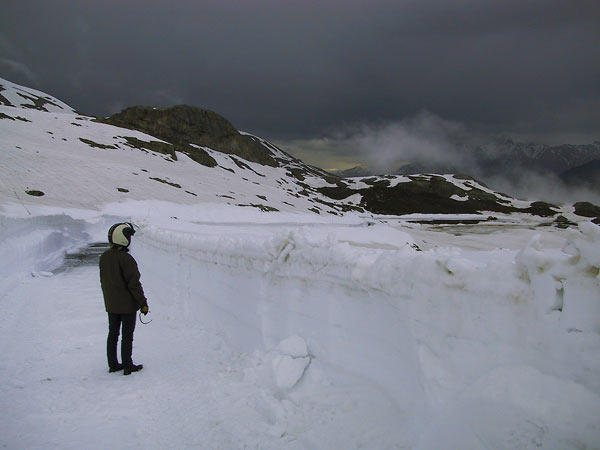
Catched in a blizzard
Of course, you can decide never to ride when the ground is covered with snow,
but sometime,s you have no choice: you are riding home, and it starts to snow.
So, what to do?
In principle, riding in fresh snow on motorcycle is possible, and is even not very hard. Try to be gentle: don't brake for corners and open the throttle once you are out of the corner, but try to ride corners without changing anything on the state of the throttle, and without using the brakes.
Do not enter turns by pushing your steer (countersteering-wise), but be gentle, and make a turn by shifting your weight.
Snow which has been driven over
It's a different story when you ride over snow which has been driven over by cars. Such snow has become slippery, very slippery.
The biggest danger in that situation is that a slippery road is less dangerous for drivers of cars, with their four wheels, and often will maintain a higher speed than what is safe for you on a motorcycle.
Car drivers will notice that the road is slippery when they have to brake. And that's not a nice thought, when you see such a car millimeters behind you, in your mirror...
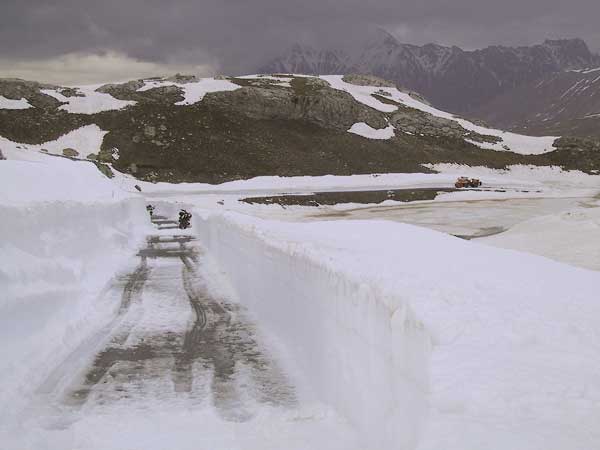
Visor
Snow is a nuisance for what you can see. Not only the snow flocks will hinder your vision, but the flocks will be glued tightly to your visor as well.
Of course, in the case of snow, the same applies what has been said for rain and mist: make sure your visor is clean and polished.
And if it's dark as well
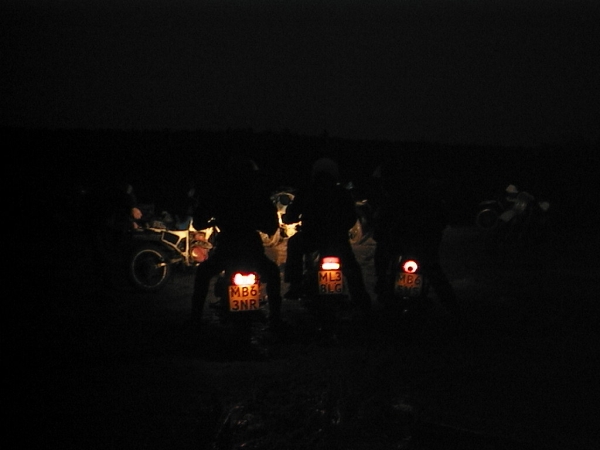
I don't see anything!
Riding in the dark is difficult, for the first time: at first, you get the impression that you can't see anything at all.
But once you've come across a road without white markers or stripes, you will realize how much you can see on roads with those markers!
The thing is, you should be aware of other aspects of the road than what you are used to watch during the day: the white stripe in the middle, the stripes at the side of the road, reflectors or posts.
I see even more!
The nice thing of riding in the dark, is that it enhances your view in some respects:
You will see an oncoming vehicle long before you can spot the vehicle itself, by its lights that shine through the dark. You are even able to look around a corner, because you will spot the lights before the car is visible.
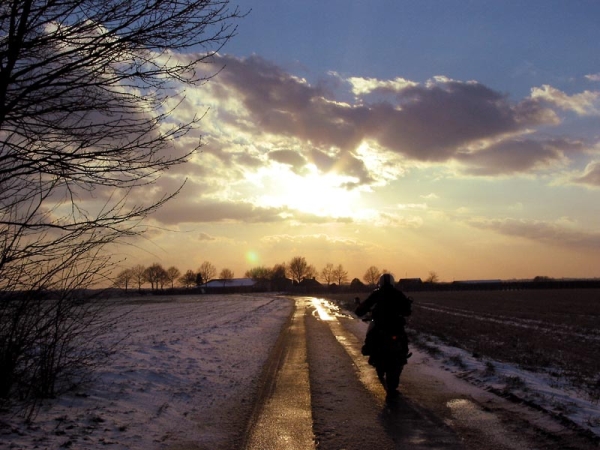
The sun behind you
When the sun is close to the horizon, and you ride with the sun in your back,
your view on the world before you is excellent.
But if you ride toward that same sun, it is very difficult to see what's before you.
Of course, you should always switch on your headlight, but in case of a setting or rising sun, it's even more important to do so.
And, the other way around, keep in mind that many car drivers, with the sun behind them, do not realize that oncomming traffic can hardly spot them without their headlights on.
Dark and rain
If you ride in the dark while it's raining, it's difficult to keep a good view on the road, especially when the lights of an oncoming car diffuse. Your eyes will be blinded by the light, and you will feel like riding into a black hole.
Try to look beside the lights.
And of course, a clean and polished visor is very important in these circumstances.
You will have to take a good look to the road when there are no oncoming vehicles, and you will have to adjust your speed in such a way that the stretch of the road that you have to ride "blindly" is in your memory, in case of an oncoming car.
Reflecting signs
Something else what might help, is to switch your headlight to dimmed light when you approach a reflective sign. It will prevent being blinded by the light that is reflected.
Comments, Q & A, on a separate page




